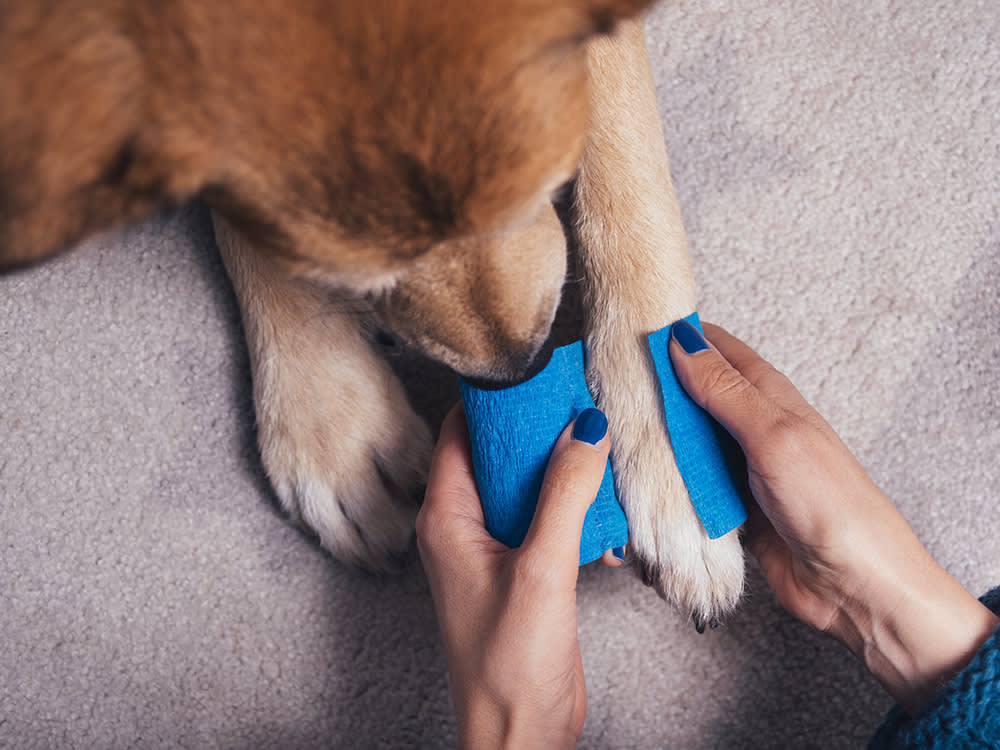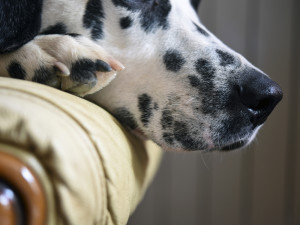How to Handle the Sight of Blood on Your Pet
Don’t freak out. Emergency room veterinarian Dr Shea Cox will walk you through what to do

Share Article
Working as a vet, I often see dogs suffering from blood loss as a result of trauma, which can become life-threatening if not properly treated. If bleeding is severe or continuous, a dog can lose enough blood to cause shock (something no pet parent wants to happen).
Shock from blood loss is classified as hypovolemic shock, which basically means that there is not enough fluid (blood) circulating throughout the dog’s body. Without an adequate volume, organs such as the kidneys and GI tract are not being perfused (nourished), and this state can quickly turn fatal in dogs. Your vet can tell if your dog is in shock through physical exam findings such as a high heart rate, a low blood pressure and weak pulses. Here are a few safe ways to control bleeding in your pet during transport to your nearest animal hospital.
The following techniques are listed in order of preference. As a word of caution: the first rule when dealing with an injured pet is to avoid injury to yourself. All too often, I see owners having to make a trip to the hospital for themselves as well as their pet. Take appropriate precautions, such as the use of a muzzle, to avoid being bitten. You can create a ‘make-shift muzzle’ by using a long piece of material such as a tie, non-retractable lead or piece of cloth.
The best way to learn these techniques is in a pet first aid class, which are available across the UK. Also, it’s a good reminder to have a complete pet first aid kit (which includes a muzzle) among your dog supplies.
Apply direct pressure
Direct pressure on a wound is the most preferable way to stop bleeding. Gently press a pad of clean cloth, gauze or even a sanitary pad over the bleeding area: this will absorb the blood and allow a clot to form.
If blood soaks through, do not remove the compress. This will disrupt the clot; simply add additional layers of cloth and continue the direct pressure more evenly. The compress can be bound in place using loosely applied bandage material, which frees your hands for other emergency actions. If you don’t have a compress, you can apply pressure with a bare hand or finger.
Elevate the wound
If a severely bleeding wound is on the foot or leg and there is no evidence of a broken bone, gently elevate the leg so that the wound is above the level of the heart. Direct pressure of the wound must be continued in addition to elevation.
Wound elevation uses the force of gravity to help reduce blood pressure in the injured area, slowing the bleeding. Elevation is most effective in larger animals with longer limbs because of the greater distance from the wound to the heart.
If external bleeding continues after you have used direct pressure and elevation, you can use your finger or thumb to place pressure over the main artery to the wound. For example, if you have severe bleeding on a rear leg, you would apply pressure to the femoral artery, which is located in the groin (on the inside of the thigh). If you have severe bleeding on a front leg, you would apply pressure to the brachial artery, which is in the inside part of the upper front leg.
Tie a tourniquet
Use of a tourniquet is potentially dangerous and should only be used for life-threatening haemorrhage in a limb. If you see blood spurting or pumping from a wound, which, luckily, is a rare occurrence, consider the use of a tourniquet.
Here’s how: use a 2-inch wide piece of cloth or lead, and wrap it around the limb twice and tie it into a knot. Then tie a short stick or similar object into the knot as well. Twist the stick to tighten the tourniquet until the bleeding stops. Secure the stick in place with another piece of cloth and write down the time it was applied. Every 20 minutes loosen the tourniquet for 15 to 20 seconds. This tourniquet technique is potentially dangerous, though, and can result in the need to amputate the limb.
Remember, a tourniquet should only be used as a last-resort, life-saving measure.
Assess for internal bleeding
Internal bleeding in dogs is another form of potentially life-threatening blood loss, when blood pools in the abdominal or chest cavity but does not result in visible blood in the stool or bleeding from the rectum. A few causes of internal bleeding in dogs include rat bait poisoning, ruptured masses on the spleen, trauma and sometimes in the case of immune-mediated disease.
Internal bleeding in dogs can often be more dangerous because it occurs inside the body, and being less obvious, delays evaluation by your vet. There are, however, some external signs of internal bleeding, which can include any of the following:
Your dog�’s gums appear pale to white.
Your dog feels cool on the legs, ears or tail.
Your dog is coughing up blood or having difficulty breathing.
Your dog is unusually subdued; progressive weakness.
Your dog experiences sudden collapse.
Your dog has a painful belly when it is touched.
IMPORTANT: if your pet is bleeding externally, or you suspect any internal bleeding with your dog, immediately transport your pet to your vet or to your closest emergency hospital for treatment.

Dr. Shea Cox, DVM, CVPP, CHPV
Dr. Shea Cox is the founder of BluePearl Pet Hospice and is a global leader in animal hospice and palliative care. With a focus on technology, innovation and education, her efforts are changing the end-of-life landscape in veterinary medicine.
Related articles
![Pet parent comforting anxious dog by holding their paw]()
8 Tips for Helping an Anxious Dog
Easy ways to calm your pup’s nerves
![A dog outside with his mouth open coughing]()
Laryngitis in Dogs: Causes and Treatment
Vet advice on when you should be worried about your dog’s cough
![English bulldog looks through a snow-covered gate]()
Is Your Dog All Bark and No Bite?
A viral video gives new meaning to being on the fence
After a Fight, Do Dogs Forgive?
Studies have shown why some dogs choose to be friendly after a fight





